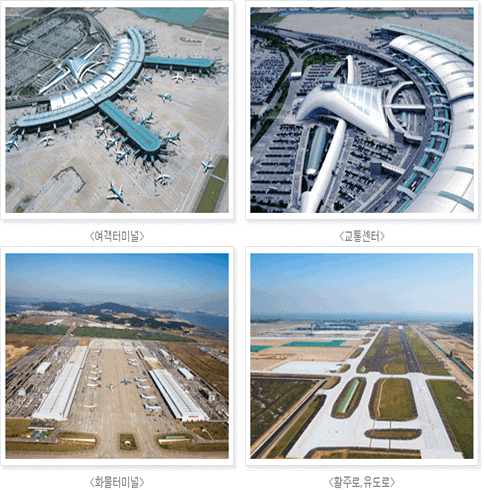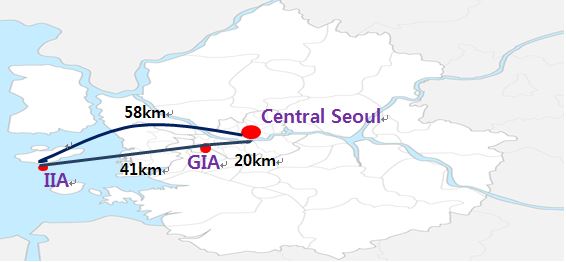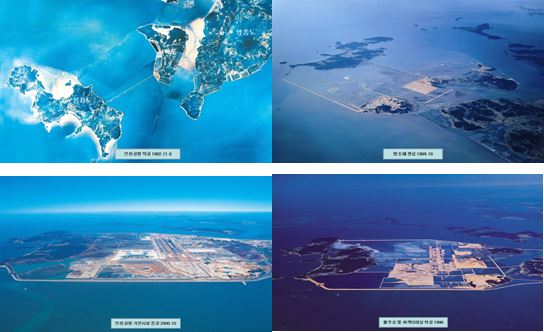1. Introduction
Most travellers visiting Korea use Incheon International Airport (IIA) as a gateway to the country. The first impressions they have of Korea come from IIA. Its facilities and systems are seen as “very advanced.” The terminal is very spacious with a high ceiling, modern design, and quick
CIQ[1] CIQ means Customs, Immigration, and Quarantine, the mandatory departure and arrival processes for airport passengers. process (only 12 minutes for arrivals).
Since its opening in 2001, IIA has been recognized as a highly successful airport, one benchmarked by many airports around the world. Several developing countries in particular plan to build a gateway airport and seek good lessons from the IIA story. In this sense, we hope this paper provides helpful insights to policy makers and airport developers around the world.
2. Accomplishments of Incheon International Airport
Traffic
IIA symbolizes Korea’s recent historical achievements. In 2016, IIA, the nation’s gateway airport, saw an international passenger traffic volume of 57.8 million (15% transfer and transit ratio), and cargo reached 2.7 million tons (39.5% transshipment ratio). IIA is ranked the world’s 7th biggest airport in terms of international passengers and 2nd for international cargo.
Service Quality
IIA is a rare case, achieving twin targets: a high level of service quality and high profitability. It has been awarded the best Airport Service Quality (ASQ) prize by
Airport Council International (ACI)[2] ACI’s ASQ (Airport Service Quality) evaluation is based on consumer satisfaction in seven service fields and 27 items related to airport facilities and operation. The service factors include the friendliness and assistance offered by airport and airline employees, CIQ processes in arrival and departure, and security checks. The facility and operation factors include restaurant, shopping, restroom, business room, baggage cart, passenger lounge, and parking, etc. consecutively for the last 12 years (2005 to 2016). Its average processing time for departures (16 minutes) and arrivals (12 minutes) are the fastest among the world’s major international airports. On average, only 0.3 out of 100 thousand passenger processed experience lost or late arriving baggage, the lowest in the world and approximately 44 times more precise than the global average. The world’s first real-time baggage traffic monitoring system was developed at IIA.
[Figure. 1 Passenger Terminal 1, Transportation Center, Runway and Taxiway, Cargo Terminal in Incheon International Airport (clockwise)]

Profitability
The 60% operating profit ratio from total revenue of US$1.9 billion is the highest among the world’s airports, and its net profit ratio of 44% yielded US$841 million in 2016. Non-aviation revenue accounts for 64% of IIA’s total revenue, one of the highest rates in the world Aviation revenue accounts for only 36%.
Rental income from duty free shops in the passenger terminal is the biggest revenue source for IIA, making up almost 60% of non-aviation revenue.[3]The rental income from duty free shop is US$716 million in 2016, which corresponds to 37.7% of total revenue. The duty free shop of IIA has recorded the biggest sales revenue among the world airports in 2016.
3. Why and Where Korea Built a New International Airport Interview video about Incheon International Airport construction history is linked. The interviewee is Kang, Dong seok who is the First president of Incheon International Airport corporation and the Former minister from the Ministry of Land, Infrastructure and Transport in Republic of Korea View
Why IIA Was Built
The main reason the government decided to build a new international airport for the Seoul metropolitan area was because the existing Gimpo International Airport (GIA) had reached capacity by the late 1980s with no room for expansion due to geographical constraints. After the government changed its restrictive international travel policy for Korean citizens to a free travel policy as part of hosting the 1988 Seoul Summer Olympics, the number of international air travellers has increased dramatically. This high growth of air travel made future congestion an easily foreseeable problem.
GIA was conveniently located very close to Seoul’s center, but it had genuine disadvantages. In addition to proximity to the DMZ and mountains constraining physical expansion, nearby residential areas prohibited 24-hour operation due to noise restrictions.
Site Selection Criteria
After the government decided to build a new international airport in the vicinity of Seoul in 1989, it took more than a year for economic feasibility tests, preliminary tests, and to find a suitable through an evaluation process.
Site selection for the new airport comprised more than 10 criteria, including 1) proximity to Seoul for easy access, within 100 kms of Korea’s capital city; 2) distance from residential areas, for 24-hour operation free from noise complaints at night; 3) sufficient airspace and good weather conditions; 4) no obstacles blocking aircraft approach for take-off and landing; and 5) affordable construction costs with abundant space for future expansions. After reviewing seven alternatives, the government finally settled on the Yeongjong-do (Island) area. The site was favorable in that land purchasing costs were reduced by demolishing small mountains on the island cluster for surrounding land reclamation. Also, noise would not be an issue as there were only a few villages nearby.
Despite the advantages of low construction cost and minimal noise problems, the location was criticized for being 58 km from the center of Seoul. But the problem of distance was overcome by building an exclusive highway for airport traffic with an airport railway constructed later on. IIA construction began in 1992, and it opened it in 2001 after a total construction period of eight years and four months.
[Figure 2. Distance of Incheon and Gimpo International Airport from Central Seoul]

[Figure 3. IIA land reclamation in 1992, 1994, 1996 and 2000] (clockwise)
